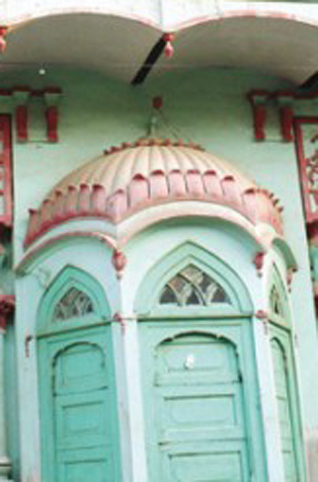Architecture
An Ode to The Sikh Raj:
A Sikh Haveli in Peshawar
HIDAYAT KHAN
Peshawar, Khyber Pakhtunkhwa, Pakistan
The haveli at Mehr Matho is one of the few well-preserved reminders of the history of Sikhs in Peshawar. A piece of heritage protected by a private owner manages to retain most of its architectural integrity, sans the small statues which used to stud the top of the building.
An example of archetypal Sikh architecture, this haveli was abandoned by Sardar Moon Singh at the time of Partition. Its intricate woodwork and detailed finish speaks of the luxury Sikh Sardars were accustomed to in the decade and a half Peshawar was ruled by Sikhs. A stark contrast to the vicious game of cat and mouse forced on them in their own city in this decade.
Since August 6, 2014, two members of this religious minority group have been murdered at their shops in this city.
Situated near Hashtnaghri gate of the Walled City, Mehr Metho Haveli is indeed part of the city and the vibrant legacy of the Sikhs. According to local elders, Mehr Matho, Mehr Sidho and Mehr Budh were three Hindu brothers after whom the area was named.
Inside the cool interior of the structure hangs a photograph of the Golden Temple in Amritsar. Haji Nadir Khan, its loving owner, informs that the haveli is more than 100 years old, though it is difficult to determine the exact date of its construction. The sexagenarian, who is in the import/export business, says his grandfather bought the building from a government magistrate who had purchased it from Sardar Moon Singh.
The haveli is spread over nine marlas or 188.1 square yards of land and the interior contains three spacious halls on the top floor and eight rooms. Two smaller halls are used by Khan for his hujra. The compound holds two garages.
The Deodar woodwork, which is often seen used in Sikh architecture in the subcontinent, brings together ornamental, architectural and religious elements. The construction material, apart from the Deodar wood, includes limestone. In line with 19th century construction, the house is well-insulated from the heat, even in summer.
The only change, says the owner, is the removal of statues on the top of the building. Khan thinks his elders removed them because they failed to understand their value.
“Unfortunately the statues cannot be brought back.”
PRIVATE EFFORTS
“This [Mehr Matho Haveli] is an archaeological gem that has been kept in its original condition through great efforts,” says Khan. “Whenever something breaks or has to be replaced, I have to hunt through old markets to find a suitable substitute.”
A number of historical sites in Peshawar are falling apart, have broken down or have been turned into big plazas, adds Khan. One such structure that collapsed recently was the historical opal tower close to Mehr Matho Haveli. The old Dean’s Hotel has been turned into the almost leviathan Dean’s Trade Centre.
Mohallah Jogan Shah which houses a majority of the city’s Sikhs has managed to retain its architectural heritage, kept alive by the Sikhs living there.
However, Jogan Shah also shows signs of rapid deterioration as its upkeep is mostly limited to a few classical facades rather than holistic preservation.
“There is no protection of sites or buildings of archaeological and architectural significance,” says Nadir. People are now shifting to posh areas such as Hayatabad or University Town, he adds. “There should be at least one such house in the old city to maintain its heritage.”
There are a number of buildings in the haveli’s vicinity which belong to the same era; one of which is being used by the city administration as a hospital. However, all of these are crumbling away.
[Courtesy: The Express Tribune. Edited for sikhchic.com]
September 30, 2014




